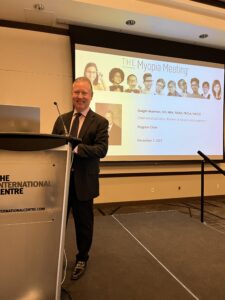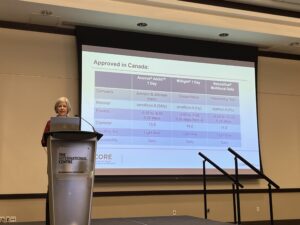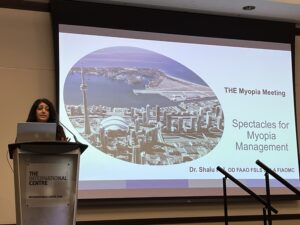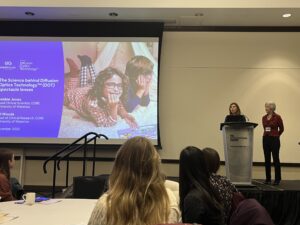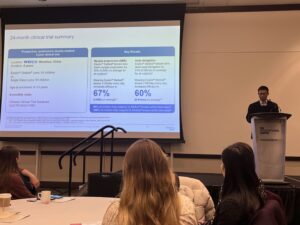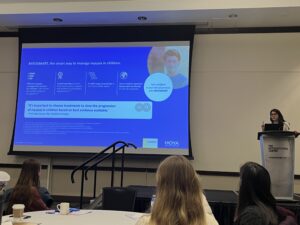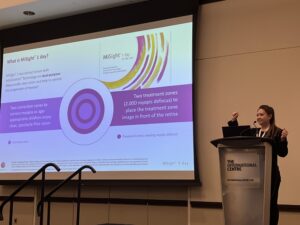December 4, 2023
TORONTO — On Sunday, December 3, leaders in the eye care field gathered here for the fourth and final live THE Myopia Meeting of 2023. The event featured four hours of COPE-approved continuing education courses interspersed with clinical reviews from some of the most influential companies and practitioners in the myopia management space.
The Latest in Instrumentation
Following a brief introduction from the meeting’s chair, Review of Myopia Management’s Chief Medical Editor Dwight Akerman, OD, MBA, FAAO, FBCLA, FIACLE, the meeting kicked off with Debbie Jones, BSc(Hons), FCOptom, FAAO, who presented: “State-of-the-Art Instrumentation for Myopia Management.”
Dr. Jones started her session by showing the steps of the myopia management eye exam: patient history, refraction, acuity, binocular vision, anterior eye exam, corneal topography, axial length, fundus exam, and management treatment plan. She then explained that this exam wouldn’t be possible without the latest instrumentation, specifically for measuring refraction, the anterior eye, topography, and axial length.
From there, Dr. Jones broke down each component of the exam and what instrumentation attendees can utilize daily to enhance their patient care. This included everything from autorefraction, slit lamps, topographers, tomographers, optical biometers, instruments that have multiple uses, and more. For autorefractors, she recommended open field designs. For measuring small children, she said, “A bit of a lost art, retinoscopy for me is an absolute must. It might be the only option for small children.”
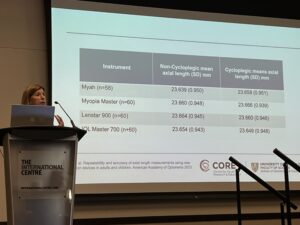
Dr. Debbie Jones’ session included the latest data on state-of-the-art instrumentation for myopia management.
On the question of whether to measure axial length, Dr. Jones said, “Do we need to measure axial length? Ideally, yes, axial length changes before refractive error changes. Can we do myopia management without measuring axial length? Absolutely, it shouldn’t hold you back.” She also pointed out that “axial length growth is highest prior to the onset of myopia.”
Dr. Jones wrapped up her discussion by comparing some of the most recently released eye care instruments. She gave attendees clinical data that can help them decide which device to bring into their practices, as well as information they can share with patients and their parents chair-side.
All About Soft Contact Lenses
Jill Woods, MSc, MCOptom, FAAO, presented the next session to attendees, finding success with soft contact lenses for myopia management. She started by explaining why soft contact lenses are an ideal choice for myopia patients: the research shows that they work to reduce both refractive error and axial length, they are recognizable and familiar to parents and children, they are a practical option — particularly for children who play sports, and they’re safe for children to wear.
To ensure patients receive the most myopia control benefits from soft contact lenses, Dr. Woods suggested three primary tips:
- Full-time wear. The more time that children spend wearing contact lenses, the more exposure they have to the treatment, and the greater the effect. Most manufacturers recommend that children wear their contacts for a minimum of six days a week for eight to 12 hours per day. “Every hour matters,” she said. “Myopia management will be more successful when wear time is maximized.”
- Start early. Similarly, the sooner you start a child in myopia treatment, the better their treatment outcome is likely to be. “Act early, don’t wait,” said Dr. Woods, “because the highest effect is often within the first treatment year.”
- Fit correctly. Not all contact lenses are fit the same way, and referring to the manufacturer’s fitting guides will ensure your patients are comfortable and getting the most of the treatment effect. However, “fitting guides are not interchangeable,” she warned.
Then, Dr. Woods transitioned into three tips for maximizing success with using soft contact lenses for myopia management:
- Maximize vision. Dr. Woods emphasized the importance of refraction, including tips on how to get the most accurate refraction, as well as how to address astigmatism.
- Maximize comfort. If patients are comfortable, they’re going to wear their contacts as designed. Dr. Woods explained that several factors influence comfort: lens design, surface and bulk chemistry, and replacement frequency. When lenses fit properly, are made with materials that have in-eye wettability, and are replaced more often, patients are going to be more comfortable.
- Minimize dropout. Dr. Woods shared that the first two items — vision and comfort — are likely to affect the chances that children stop wearing their contacts, making them all the more important to get right. Additionally, proper handling of contact lenses can affect kids’ experience with them, which makes it crucial to schedule regular follow-ups, check in with patients at home, and go over proper care instructions.
Spectacles in Myopia Management
The next continuing education course was presented by Shalu Pal, OD, FAAO, on myopia management spectacles. She started her discussion by stressing the importance of communicating with patients and their parents about myopia, including the goals, the current research, the background, and the possibilities for their child’s future eye health.
She explained that because many families are already familiar with glasses, the latest spectacle designs for myopia control can be a viable treatment option for myopic children. Dr. Pal gave a history of the evolution of myopia control spectacle lenses, and then dove into the top three new spectacle designs: HOYA’s MiYOSMART spectacles, EssilorLuxottica’s Stellest lenses, and Zeiss’ MyoCare spectacles.
“We’ve been given these lenses since 2019,” Dr. Pal said, and then after recounting some early unsuccessful attempts since 2010 to design spectacles for myopia management, she then shared information about the technology behind today’s available spectacles and their efficacy. HOYA’s DIMS technology (Defocus Incorporated Multiple Segments) reduced refractive error by 59% and axial length by 60% after two years. Essilor’s HALT technology (Highly Aspherical Lenslet Target) showed a 67% reduction in myopia progression after two years (slowing refractive error by 0.99D and with a 0.41mm change in axial length). The DOT (Diffusion Optics Technology) from SightGlass reduced refractive error by 59% and axial length by 38% after two years. The Zeiss MyoCare portfolio of lenses launched in China in 2022 (where one million pairs have already been sold) and in Canada in 2023. Efficacy data on MyoCare will be released at ARVO in 2024.
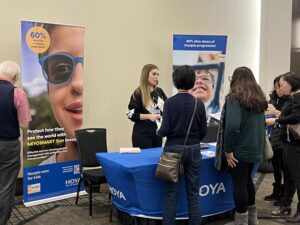 |
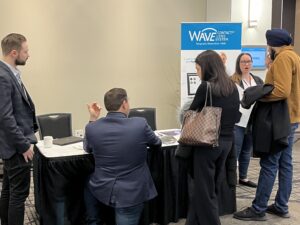 |
In between CE sessions and clinical review presentations, attendees got to spend time networking with leaders in the field.
‘Myopia Management From A to Z’
Dr. Akerman gave the last continuing education presentation of the day, breaking down everything practitioners need to know about myopia management, including: global prevalence, long-term eye health complications, risk factors for developing myopia and high myopia, treatment options, centile charts, ending myopia treatment, and the benefits of early intervention.
Dr. Akerman explained that myopia management offers both challenges and opportunities for practitioners. There are questions regarding who to treat, when to start treatment, what treatment to choose, and when to stop treatment. He went on to address each of these points in his presentation, giving attendees tangible clinical advice to utilize in their practices.
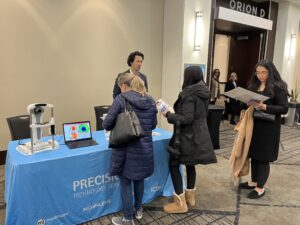 |
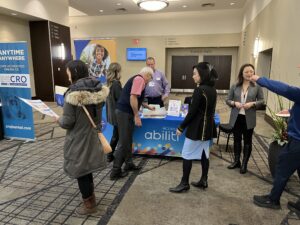 |
Attendees were able to meet with and learn from leading manufacturers in the myopia management field.
To close things out, Dr. Akerman emphasized the importance of being proactive in treating myopia, as doing so can not only benefit children’s long-term eye health, but also improve their quality of life in the present and the future.
Clinical Reviews
Throughout the day, clinical reviews were presented by event sponsors SightGlass Vision, EssilorLuxottica, HOYA Vision Care, Johnson & Johnson Vision, and CooperVision.
In addition to their CE presentations, Drs. Jones and Woods presented together for SightGlass Vision, discussing the company’s CYPRESS trial, which utilizes diffusion optics technology (DOT) that powers the DOT 0.2 spectacle lenses. They explained that CYPRESS is a prospective, randomized, controlled, subject- and observer-masked multi-site three-arm parallel group clinical trial, evaluating the safety and efficacy of DOT spectacle lenses in reducing the progression of myopia. Some highlights from the study so far include: 59% slowing of myopia progression over two years when worn fulltime, strong efficacy in the fourth year of treatment, highly effective in the youngest patients — ages 6-7 — who have the fastest progression, and the only single vision lens that provides myopia control through contrast management.
Jason Shen, PhD, presented next on behalf of EssilorLuxottica, sharing the two-year, three-year, and four-year results of clinical trials for Stellest lenses with HALT technology. Among the results he shared supporting the fact that “Essilor Stellest lenses are very effective for myopia management in terms of myopia progression and axial length elongation,” were that over three years, myopia progression was reduced by 1.00D. Fourth year results continued showing positive results for myopia control. Another study in Vietnam showed no rebound effect.
Next up, Radhika Chawla, OD, presented for HOYA. Dr. Chawla began her presentation discussing the most recent clinical findings on the MiYOSMART spectacle lenses and its DIMS technology. She explained that MiYOSMART wearers experienced a 60% slow down of myopia progression, with the effect lasting over six years. Additionally, Dr. Chawla shared that there was no rebound effect when children stopped wearing MiYOSMART lenses. Throughout the presentation, Dr. Chawla also discussed the sun range options of MiYOSMART lenses, which allow children to maintain myopia treatment when they’re outdoors.
Monica Jong, OD, PhD, and Langis Michaud, OD, MSc, FAAO, FSLS, FBCLA, FEAOO, were the next clinical review presenters for Johnson & Johnson Vision. They started their presentation with details of a case study — an 8-year-old patient named Andy who was diagnosed with myopia at 6 years old and broke his glasses just so he wouldn’t have to wear them. Andy’s doctor prescribed ACUVUE Abiliti 1-day lenses, and Dr. Michaud shared Andy’s results after wearing the lenses for three months, six months, one year, and two years. They explained that through six months of treatment, Andy’s myopia didn’t progress at all; at one year, there was a 0.12 mm change in axial length (which is comparable to emmetropes); at two years, axial length changed 0.32 mm and refractive error changed 0.50D. After sharing Andy’s story, Dr. Jong wrapped up their presentation by sharing more about the ACUVUE Abiliti 1-day lenses — the lens design, clinical data regarding axial length progression and visual acuity, resources and materials to share with parents, and more.
Dr. Jong also shared for the first time ever the one-year results of the clinical trial of ACUVUE Abiliti 1-day lenses. She announced that in one year the lenses slowed myopia progression by 0.19mm, which is comparable to half a diopter. “This is a world first that I’m going to announce here today. We have one-year results. At one year, the ACUVUE Abiliti 1-day lens was able to slow axial elongation by 0.19mm compared to the single vision lens. This is a little over 0.50D in one year.”
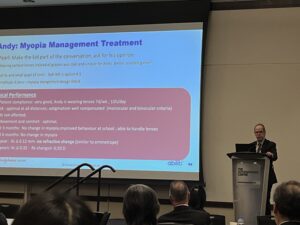 |
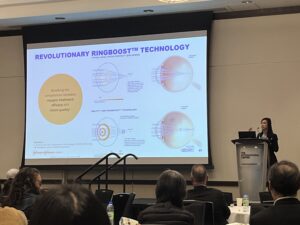 |
Drs. Langis Michaud and Monica Jong presented on behalf of Johnson & Johnson Vision.
CooperVision had the final clinical review of the day, with Amy Chow, FAAO, FBCLA, presenting for the company. She started her presentation discussing myopia in general and that Canada has adopted myopia management as the standard of care. She then focused her presentation on MiSight 1 day, first discussing the technology and then the seven-year MiSight 1 day clinical trial, breaking down each of the three parts of the study and the seven years of data. “The longest clinical trial when it comes to a soft contact lens for myopia control,” she said. “The only FDA and Health Canada approved soft lens for myopia control.”
She then explained that following year seven of the study, CooperVision studied the rebound effect, in addition to answering many common questions, including: Will MiSight 1 day work for all children? How effective is MiSight? When should you start treatment with MiSight? When should you stop treatment? And most important, what’s going to happen when you stop.
Here were the answers: “MiSight 1 day works for nearly all age-appropriate children. It cuts myopia by half. While early intervention is best, it doesn’t matter even if they are at an older age it is still going to be effective. MiSight 1 day will work as long as the child is in the lens. And finally the evidence indicates that there is no rebound effect.”
THE Myopia Meeting Conference Speakers and Sponsors Share Event Highlights
To get more insight into the field of myopia management from the leading experts in the field, Review of Myopia Management went straight to the source. Listen to the short interview clips below with speakers and sponsors of THE Myopia Meeting to learn more about the latest myopia management topics.
Monica Jong, OD, PhD
Langis Michaud, OD, MSc, FAAO, FSLS, FBCLA, FEAOO
Radhika Chawla, OD
Steve Reiman, SightGlass Vision
Jason Shen, PhD
Debbie Jones, BSc(Hons), FCOptom, FAAO
Jill Woods, MSc, MCOptom, FAAO
Shalu Pal, OD, FAAO
Amy Chow, OD, FAAO, FBCLA


